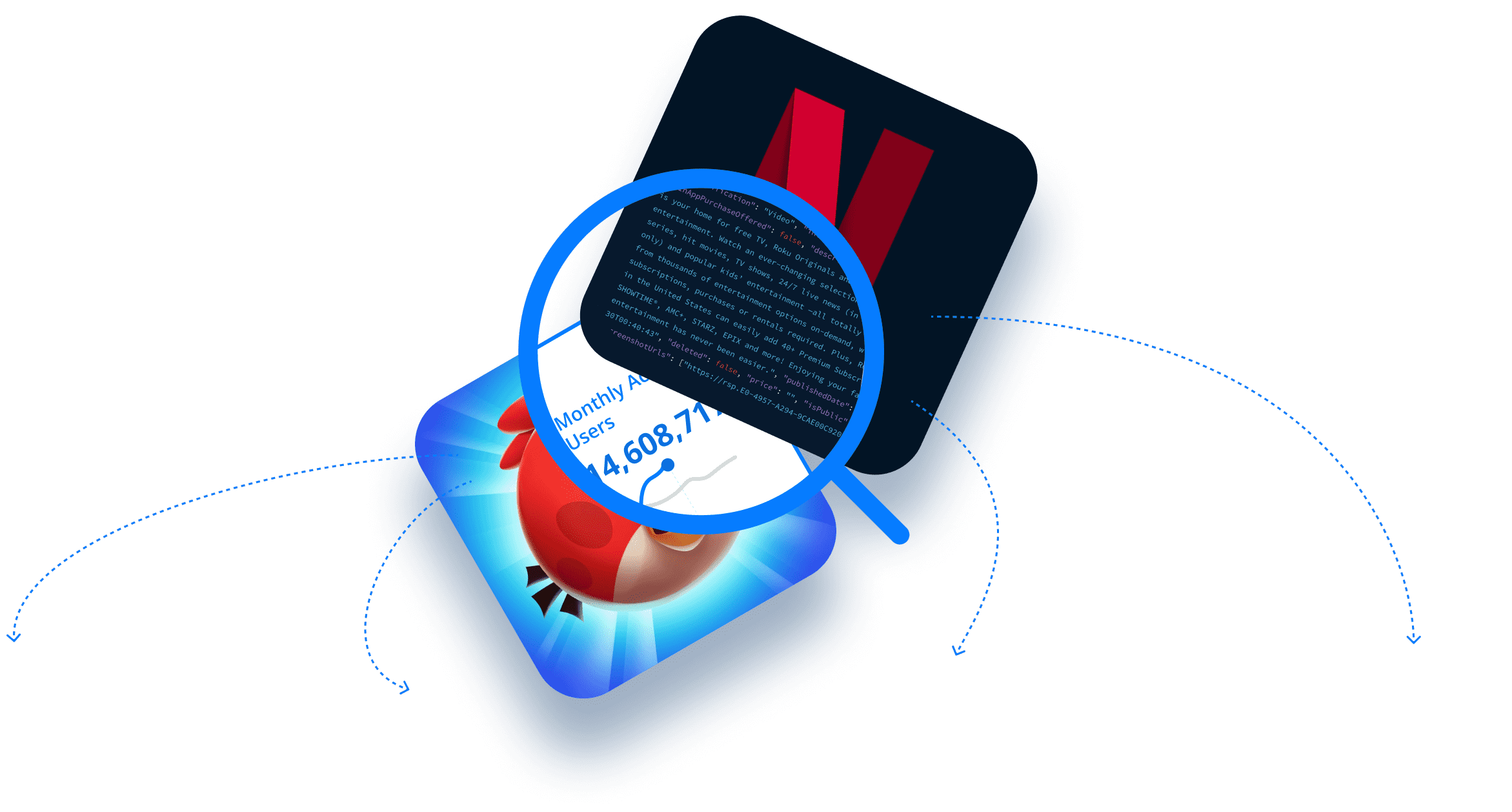Mobile Application Management (MAM) Key Takeaways:
- MAM refers to the management of the security, governance, and distribution of mobile apps, typically within an enterprise.
- MAM differs from mobile device management (MDM), which focuses on establishing enterprise security policies at the device level.
- MAM enables businesses to secure against a wide range of potential attack vectors and risks, without inhibiting employee productivity or satisfaction.
- 42matters can help improve MAM by offering incisive, actionable app intelligence for 14+ million published and unpublished apps, accessible via file dumps and APIs.
Want to see how 42matters’ datasets can boost MAM? Set up a free live demo!
For organizations, data security is critical. While advancements in mobile technologies and enterprise communications have made conducting business easier and more efficient than ever, they’ve also opened up a whole new front in the war of cyber security.
Making matters worse, coronavirus has sped along the “Remote Work Revolution,” forcing many businesses to adopt risky “Bring Your Own Device” (BYOD) policies to ensure their employees are able to stay productive despite global lockdowns and shelter-in-place orders. And, of course, since the European Union passed the General Data Protection Regulation (GDPR), enterprises are no longer allowed to implement top-down control over employees’ personal devices.
The failure to cope with these challenges could have serious financial and reputational consequences, including crippling cyber-attacks, lackluster employee productivity, lost business, nervous investors, indignant press coverage, and class action lawsuits. This is why it’s absolutely essential for businesses to implement a comprehensive Mobile Application Management (MAM) strategy.
We wrote this article to help organizations get started with MAM. We answer the following questions:
- What is Mobile Application Management?
- What’s the difference between Mobile Application Management and Mobile Device Management?
- Why is Mobile Application Management important?
- Why do organizations need Mobile Application Management?
- How does Mobile Application Management work?
So, with that, let’s get started!
What is Mobile Application Management (MAM)?
Broadly speaking, Mobile Application Management (MAM) refers to the administration of mobile applications on corporate and personal smartphones, tablets, and other mobile devices. MAM is generally facilitated by corporate administrators via software platforms that enable them to monitor app lifecycles, including installations, deletions, updates, licenses, permissions, configurations, etc. Such platforms are typically procured from outside vendors but are sometimes developed internally. That said, the term also encompasses the various and sundry policies, processes, and tools implemented to guarantee corporate security and foster employee productivity.
It should also be noted that MAM policies differ from company to company. Indeed, while many companies still provide employees with corporate devices, more and more are adopting a “Bring Your Own Device” (BYOD) approach. While we’re happy to let the market debate the virtues of each strategy, we will note that, whichever option a business chooses, it will affect the MAM strategies they implement.
What’s the difference between Mobile Application Management (MAM) and Mobile Device Management (MDM)?
While MAM facilitates granular controls at the app level, enabling system administrators to manage and secure app data, Mobile Device Management (MDM) is predicated on the ability to control an entire device. This typically means that users have to enroll their devices with an administrator and install a service agent solution to assure compliance.
There are certainly benefits to MDM, but it only addresses security at the device level, leaving businesses and individuals vulnerable to corrupt mobile apps or fraudulent SDKs.
Moreover, MDM often depends on a cumbersome degree of IT compliance, requiring users to turn off certain features, use specific browsers and operating systems, and agree to the monitoring of their usage, location, and data.
This is especially an issue for businesses that rely on BYOD to keep employees connected. While GDPR prevents businesses in the EU from implementing the most intrusive MDM practices to secure employee devices, the simple fact of the matter is that it’s not particularly popular. Most people don’t want their employers to manage their devices — personal or corporate. MAM platforms stand in sharp contrast to MDM offerings in that they enable IT managers to separate private apps from those that are used by their organization, reducing the amount of control they have over a user’s device.
Why is Mobile Application Management (MAM) important?
Back in the good ol’ days, businesses leveraged MDM software to facilitate device activation, device enrollment and provisioning, remote wiping, and other device-level functionalities. However, MDM was the product of an ecosystem in which organizations purchased mobile devices for employees, who used them for work-related purposes only. So, when the BYOD revolution was launched in earnest, following Apple’s 2007 release of the iPhone, MDM solutions quickly fell out of favor.
As more and more employees began working from their own devices, it became correspondingly more difficult for organizations to manage employee behavior and keep company data secure. Indeed, unsurprisingly, employees were reluctant to give IT departments the power to remote wipe their personal devices or blacklist certain apps. This, in conjunction with GDPR, resulted in many employee devices going unsecured, leaving corporate data and systems open to cyber attacks.
This is where MAM enters the story. By enabling IT administrators to deploy comprehensive, high-resolution security policies aimed at individual apps (as opposed to entire devices), MAM solutions bring apps “under management” without restricting access to the tools and data people need to do their jobs or live their lives. In fact, for Android devices, MAM solutions give administrators the option to distinguish between business and private apps, allowing for the creation of separate “work” and “personal” profiles on single mobile devices. This means better security, better productivity, and happier employees.
Why do organizations need Mobile Application Management (MAM)?
While many businesses still use MDM to set up mobile devices and manage mobile email, the rise of the mobile app economy has nevertheless continued to push MDM towards obsolescence since it fails to address the security risks associated with mobile app usage. What’s more, regulators, especially in the EU, are increasingly hostile to third-party device management.
Fortunately, MAM offers organizations a solution, by providing high-quality mobile security via policies and management at the application level. Indeed, for enterprises, MAM supports enterprise mobility management (EMM) in creating a safe, compliant app space while still enforcing device security. As such, it facilitates secure access to critical back-end systems, meaning work that once required employees to be on a managed device or in-office can be accomplished in the field — anytime, anywhere.
MAM also enables organizations to circumvent the challenge of securing apps and data for BYOD users, contractors, or other outside workers; operating under the premise that the less a device is controlled by IT, the more effective a user can be.
How does Mobile Application Management (MAM) work?
If you want to develop a comprehensive MAM strategy, here are four approaches to keep in mind before you get started:
- Software Development Kits (SDKs) and Application Wrapping — By adding an additional piece of code to an app, either during the installation of an SDK or after the app wrapping process, businesses can connect apps to back-end MAM software. This will enable IT administrators to apply and enforce MAM policies and keep data secure.
- Containerization (Sandboxing) — This approach involves isolating specific apps by placing their data within a ‘container’ and preventing them from interacting with other apps on a device.
- Device-level MAM — This is a newer method that gives IT administrators the ability to control and secure apps via MDM protocols built into a device’s operating system.
- Enterprise App Store — An enterprise app store is essentially a private app catalog curated by someone within an organization. They’re similar to commercial app stores, such as the Apple App Store or Google Play, except that they’re designed to enable authorized users (employees, contractors, etc.) to browse a selection of pre-approved mobile apps and download whichever they need.
How to leverage 42matters’ app intelligence to create, enrich, or improve your Mobile Application Management (MAM) strategy
Whichever approach you take, 42matters is here to help with your app intelligence requirements. Via our rich datasets and suite of APIs, we offer insight into 14+ million published and unpublished apps, from 2.6+ million publishers, across Google Play, the Apple App Store, Amazon Appstore, and Tencent Appstore.
Our datasets will enable you to compare app names, packages/IDs, descriptions, icons, and app fingerprints to flag copycat apps. You’ll also have insight into such things as suspiciously low downloads, bad ratings and reviews, intrusive permissions, integrated SDKs, unusual update/publication histories, and more. As such, you’ll be able to keep your company data secure and bolster your MAM policies by helping your employees avoid potentially harmful apps. To learn more about how to access our datasets, this blog will walk you through the process.
While we offer a wide range of file dumps, which you can check out at our “Getting Started” page, these are the most relevant to MAM:
- App Details (see sample data) — Access detailed information for any app, including: name, description, category, pricing details, ratings, downloads, release dates, content localization, and more. View apps from Google Play, the Apple App Store, Amazon Appstore, and Tencent Appstore.
- SDK Intelligence — View the SDKs and permissions leveraged by any mobile app. We track 2,500+ SDKs and hundreds of iOS and Android permissions.
- Reviews Analysis — Access an extensive database of anonymized reviews, including advanced sentiment analysis.
- Top Charts (see sample data) — View daily top charts for either Google Play or the Apple App Store.
- IAB Categories for Apps (see sample data) — The Interactive Advertising Bureau’s (IAB) content taxonomy offers a more precise alternative to Google’s app categories and Apple’s app genres. Access IAB category information for any app.
- app-ads.txt for Apps (see sample data) — View app-ads.txt data for any app available on Google Play, the Apple App Store, Amazon Appstore, and more.
- App Content Ratings (see sample data) — Access app content ratings by country for both Google Play and the Apple App Store. This includes content rating insights from ESRB (Americas), PEGI (Europe, Middle East), USK (Germany), Australian Classification Board (Australia), ClassInd (Brazil), GRAC (South Korea), IARC (Generic), and the Apple App Store Rating System.
For access credentials to full file dumps, feel free to reach out!
In addition, we offer the following, security-focused file dumps: Android and iOS APK Resources and File Structure, Android SDKs URLs, and Android App Signing Certificate: SHA-1, SHA-256, and MD5. And, of course, we’d be happy to create custom data sets based on your particular needs.
If you would like to learn more about how our file dumps and APIs can improve your Mobile Application Management strategy, schedule a free demo with one of our experts!



